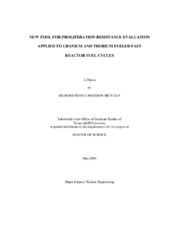| dc.description.abstract | The comparison of nuclear facilities based on their barriers to nuclear material
proliferation has remained a difficult endeavor, often requiring expert elicitation for each
system under consideration. However, objectively comparing systems using a set of
computable metrics to derive a single number representing a system is not, in essence, a
nuclear nonproliferation specific problem and significant research has been performed
for business models. For instance, Multi-Attribute Utility Analysis (MAUA) methods
have been used previously to provide an objective insight of the barriers to proliferation.
In this paper, the Proliferation Resistance Analysis and Evaluation Tool for Observed
Risk (PRAETOR), a multi-tiered analysis tool based on the multiplicative MAUA
method, is presented. It folds sixty three mostly independent metrics over three levels of
detail to give an ultimate metric for nonproliferation performance comparison. In order
to reduce analysts' bias, the weighting between the various metrics was obtained by
surveying a total of thirty three nonproliferation specialists and nonspecialists from fields such as particle physics, international policy, and industrial engineering. The
PRAETOR was used to evaluate the Fast Breeder Reactor Fuel Cycle (FBRFC). The
results obtained using these weights are compared against a uniform weight approach.
Results are presented for five nuclear material diversion scenarios: four examples
include a diversion attempt on various components of a PUREX fast reactor cycle and
one scenario involves theft from a PUREX facility in a LWR cycle. The FBRFC was
evaluated with uranium-plutonium fuel and a second time using thorium-uranium fuel.
These diversion scenarios were tested with both uniform and expert weights, with and
without safeguards in place. The numerical results corroborate nonproliferation truths
and provide insight regarding fast reactor facilities' proliferation resistance in relation to
known standards. | en |


